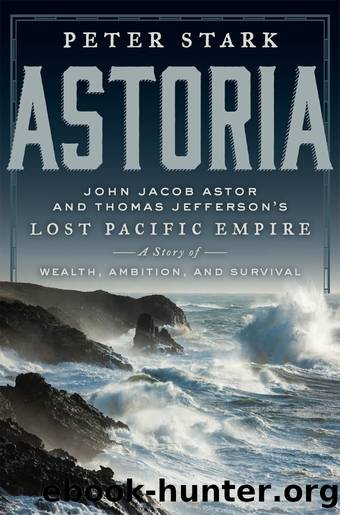Stark, Peter - Astoria: John Jacob Astor and Thomas Jefferson's Lost Pacific Empire by Stark Peter

Author:Stark, Peter [Stark, Peter]
Language: eng
Format: epub
Publisher: HarperCollins
Published: 2014-03-04T00:00:00+00:00
CHAPTER SIXTEEN
ASTOR’S LEADERS WERE, IN MANY WAYS, HIS SURROGATES. Astor had chosen Captain Thorn to sail the Tonquin because he was decisive, because he would fight, because he was sure to defend with steely courage Astor’s fledgling empire. Jonathan Thorn would make the perfect commander in a blazing cannon-to-cannon naval battle against a British or Spanish warship that might threaten to attack the West Coast emporium. But it was a very different adversary, as it turned out, that Captain Thorn would face on his first trading voyage up the West Coast.
Impatient as ever to be on his way, Captain Thorn, after unloading his ship at Astoria and crossing the Columbia Bar out to the open ocean on June 5, had sailed north up the Pacific Coast to trade for sea otter furs in the Coastal Indian villages along today’s Vancouver Island. He then was to return to Astoria and load more furs for the cross-Pacific voyage to China, furs that had been collected from the beginnings of a vast web of Astor posts reaching into the interior. Instead of officers, Captain Thorn carried on his ship the most experienced Scottish trader, Alexander McKay, and clerk James Lewis. While en route up the coast, the Tonquin put in at an Indian village near today’s Gray’s Harbor, Washington, and took aboard one more passenger when Thorn and MacKay hired an Indian interpreter, Joseachal, who spoke the Coastal dialects of Vancouver Island.
The Tonquin sailed for a village known as Newetee on Vancouver Island, about two hundred miles north of Astoria. As they made their way north, Joseachal warned Captain Thorn that the Indians of Newetee could be treacherous and held a grudge against an earlier American trading vessel whose crew had mistreated them. Ignoring the native’s warnings, Thorn dropped anchor in Newetee’s cove around that second week of June 1811. (The cove has since been identified as Templar Channel of Clayoquot Sound, British Columbia.) Trader McKay and interpreter Joseachal went ashore to open trade negotiations. The village chiefs received them with warm hospitality, and the two spent the night in a chief’s Clayoquot longhouse on the traditional cedar benches draped with thick sea otter furs.
Out in the cove on board the Tonquin, negotiations unfolded less smoothly. The Indians’ big cedar canoes, with their long snoutlike prows, pulled alongside the ship’s hull. Their paddlers, the Clayoquot, wore woven cedar-bark clothing and weatherproof conical hats. The paddlers held up rolls of sea otter furs to trade. Captain Thorn, the naval hero with no experience in the Indian trade, and his chief trader onshore at the villages, ordered a tempting array spread out on his deck of blankets, knives, blue beads, pots, and other trade goods. An elderly Indian chief named Nookamis climbed aboard to establish the prices in trade goods for furs. Captain Thorn made an offer—two blankets and a few smaller items such as fishhooks and beads in exchange for one sea otter fur.
Known to be a shrewd bargainer among the Coastal Indians, Nookamis contemptuously rejected Captain Thorn’s offer as far too low.
Download
Stark, Peter - Astoria: John Jacob Astor and Thomas Jefferson's Lost Pacific Empire by Stark Peter.epub
This site does not store any files on its server. We only index and link to content provided by other sites. Please contact the content providers to delete copyright contents if any and email us, we'll remove relevant links or contents immediately.
| Birdwatching | Boating |
| Canoeing | Caving & Spelunking |
| Cycling | Fishing |
| Hiking & Camping | Hunting |
| Iditarod & Dog-Sledding | Kayaking |
| Mountaineering & Climbing | Rafting |
| Sailing | Scuba |
| Skiing | Snowboarding |
| Surfing |
Ultimate Navigation Manual by Lyle Brotherton(1767)
Welcome to the Goddamn Ice Cube by Blair Braverman(1601)
The Box by Marc Levinson(1595)
Diver Down by Michael Ange(1194)
Backcountry Bear Basics by Dave Smith(1128)
The Backpackers Handbook by Chris Townsend(1058)
Animal Speak by Ted Andrews(1012)
Jazz by Toni Morrison(983)
One of the Guys by A.R. Perry(917)
The Boys in the Cave by Matt Gutman(907)
Living_by_the_Code_v1.1.1 by 2019(907)
Blind Descent by James M. Tabor(886)
DK Eyewitness Travel Guide Japan by DK Travel(870)
006 White Water Terror by Carolyn Keene(845)
The Tree Climber's Guide by Jack Cooke(834)
365 Days Wild by Lucy McRobert(817)
Another Country (Vintage International) by James Baldwin(816)
The White Spider by Heinrich Harrer(778)
Skybound by Rebecca Loncraine(774)
